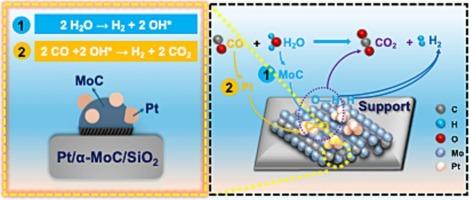相对于三元Pt-Mo/SiO2催化剂,Mo-Si界面层促进了PtMo活性位点的形成,促进了高效的水煤气转移反应
IF 13.2
1区 工程技术
Q1 ENGINEERING, CHEMICAL
引用次数: 0
摘要
立方结构α相碳化钼负载金属催化剂(M/α-MoC)在水煤气转换反应中表现出优异的低温活性,在燃料电池氢处理和净化方面具有重要的应用潜力。而传统体积相Pt/α-MoC催化剂的比表面积相对较低。同时,α-MoC较低的机械强度也限制了粉末M/α-MoC的成型应用。在本研究中,设计了一种新型Pt/α-MoC/SiO2三元催化剂体系,以整合Pt/α-MoC活性位点和商业SiO2载体的优点。综合表征结果证实,电取代(GR)方法可以在负载型三元催化剂中精确定位Pt在α-MoC上,促进了丰富的PtMo界面活性位点的形成。此外,α-MoC与SiO2载体之间形成了稳定的MoSi界面层,有效地分散了Pt/α-MoC组分,同时改变了它们的电子性能。经改性后,Pt/α-MoC活性部位CO中毒减弱,水解离加快。最终,Pt/α-MoC/SiO2-GR催化剂表现出优异的催化性能,在523 K下,其固有活性为9.9 molCO/molPt/s,比本体Pt/α-MoC催化剂高63 %。本文章由计算机程序翻译,如有差异,请以英文原文为准。

Mo-Si interfacial layer promoted PtMo active sites over ternary Pt-Mo/SiO2 catalyst for efficient water-gas shift reaction
Cubic structured α-phase molybdenum carbide supported metal catalysts (M/α-MoC) present excellent low-temperature activity in water gas shift reaction and exhibit significant potential for hydrogen processing and purification in fuel cell applications. However, the specific surface area of conventional bulk-phase Pt/α-MoC catalysts is relatively low. Meanwhile, the low mechanic strength of α-MoC also limits the molding of powder M/α-MoC for application. In this study, a novel Pt/α-MoC/SiO2 ternary catalyst system was designed to integrate the advantages of Pt/α-MoC active sites and commercial SiO2 support. Comprehensive characterization results confirmed that the galvanic replacement (GR) method could precisely position Pt on α-MoC and promote the formation of abundant Pt Mo interface active sites in the supported ternary catalyst. Moreover, the formation of a stable Mo
Mo interface active sites in the supported ternary catalyst. Moreover, the formation of a stable Mo Si interfacial layer between α-MoC and the SiO2 support effectively disperses the Pt/α-MoC components while modifying their electronic properties. With the modification, the CO poisoning on the Pt/α-MoC active site is weaken and the water dissociation are boosted. Eventually, the Pt/α-MoC/SiO2-GR catalyst exhibited superior catalytic performance, with an intrinsic activity of 9.9 molCO/molPt/s at 523 K, which is 63 % higher than that of bulk Pt/α-MoC catalysts.
Si interfacial layer between α-MoC and the SiO2 support effectively disperses the Pt/α-MoC components while modifying their electronic properties. With the modification, the CO poisoning on the Pt/α-MoC active site is weaken and the water dissociation are boosted. Eventually, the Pt/α-MoC/SiO2-GR catalyst exhibited superior catalytic performance, with an intrinsic activity of 9.9 molCO/molPt/s at 523 K, which is 63 % higher than that of bulk Pt/α-MoC catalysts.
 Mo interface active sites in the supported ternary catalyst. Moreover, the formation of a stable Mo
Mo interface active sites in the supported ternary catalyst. Moreover, the formation of a stable Mo Si interfacial layer between α-MoC and the SiO2 support effectively disperses the Pt/α-MoC components while modifying their electronic properties. With the modification, the CO poisoning on the Pt/α-MoC active site is weaken and the water dissociation are boosted. Eventually, the Pt/α-MoC/SiO2-GR catalyst exhibited superior catalytic performance, with an intrinsic activity of 9.9 molCO/molPt/s at 523 K, which is 63 % higher than that of bulk Pt/α-MoC catalysts.
Si interfacial layer between α-MoC and the SiO2 support effectively disperses the Pt/α-MoC components while modifying their electronic properties. With the modification, the CO poisoning on the Pt/α-MoC active site is weaken and the water dissociation are boosted. Eventually, the Pt/α-MoC/SiO2-GR catalyst exhibited superior catalytic performance, with an intrinsic activity of 9.9 molCO/molPt/s at 523 K, which is 63 % higher than that of bulk Pt/α-MoC catalysts.
求助全文
通过发布文献求助,成功后即可免费获取论文全文。
去求助
来源期刊

Chemical Engineering Journal
工程技术-工程:化工
CiteScore
21.70
自引率
9.30%
发文量
6781
审稿时长
2.4 months
期刊介绍:
The Chemical Engineering Journal is an international research journal that invites contributions of original and novel fundamental research. It aims to provide an international platform for presenting original fundamental research, interpretative reviews, and discussions on new developments in chemical engineering. The journal welcomes papers that describe novel theory and its practical application, as well as those that demonstrate the transfer of techniques from other disciplines. It also welcomes reports on carefully conducted experimental work that is soundly interpreted. The main focus of the journal is on original and rigorous research results that have broad significance. The Catalysis section within the Chemical Engineering Journal focuses specifically on Experimental and Theoretical studies in the fields of heterogeneous catalysis, molecular catalysis, and biocatalysis. These studies have industrial impact on various sectors such as chemicals, energy, materials, foods, healthcare, and environmental protection.
 求助内容:
求助内容: 应助结果提醒方式:
应助结果提醒方式:


